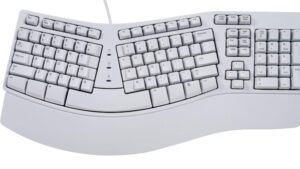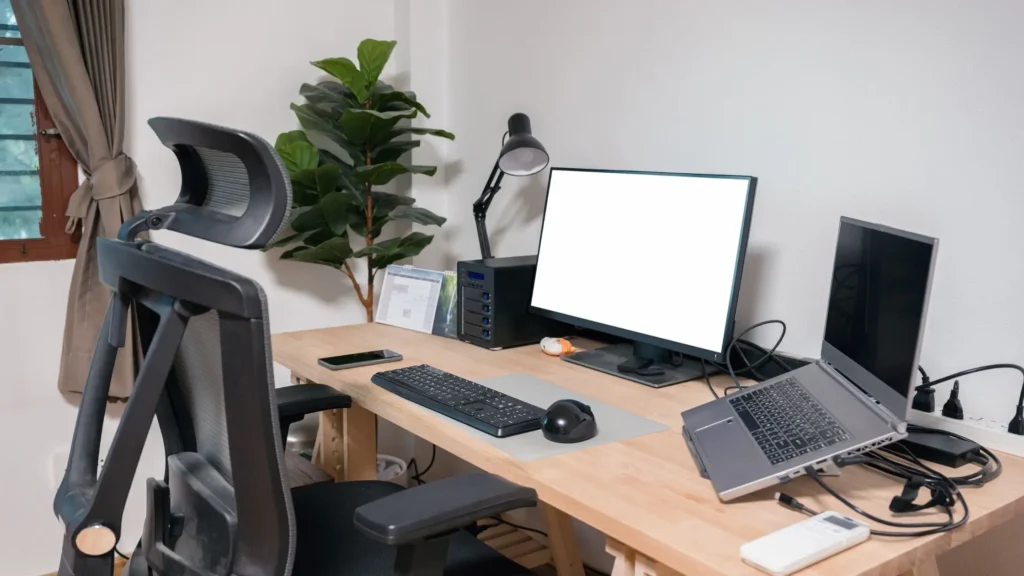Setting up a proper workstation as a writer is a form of self-care. My frequent interaction with other remote writers, combined with my personal experience, made me realize how prioritizing my physical well-being makes productivity easier. With this ergonomic workstation setup checklist, you too can ensure that your body receives all the necessary support it deserves.
So when you begin your day with the right stretches and a well-arranged workstation, your writing sessions become ache-free, and your muse works at its best. I made a list of the exact items we writers swear by, from chair height and lumbar support to keyboard tilt and monitor position.
You may want to sit with a notepad and a pen to write down this list and check off the items as you set up your workstation. A proper definition first.
What is an ergonomic workstation setup?
An ergonomic workstation setup is an intentional arrangement of your desk, chair, tools, and overall posture to support the body while working. For writers, it’s a necessity. Think about how long we sit in one position, fingers dancing on keyboards, backs stiffening with time. Sticking to an ergonomic writing desk setup checklist helps you adjust every single element to avoid physical stress while writing.
To ensure you are on the right track, you’ll need an ergonomic chair for writers that provides lumbar support, adjust your monitor so it aligns with eye level, and set your desk at the proper height. Each of these changes may seem small in isolation, but collectively, they shape how your body responds to prolonged periods at the desk. A proper work posture is not the only thing a writer benefits from checking off on this list. Let’s find out more below.
How do writers benefit from an ergonomic desk setup?
Let me tell you this with all the passion I could muster: writers are storytellers, strategists, researchers, and thinkers. However, none of that flows smoothly when you’re distracted by a throbbing neck or an aching back. An ergonomic workstation setup for writers is tailored to eliminate these distractions by making comfort an integral part of your workflow.
Here’s how we benefit from an intentional desk setup:
- Pain reduction: A properly adjusted ergonomic desk maintains a neutral spine position and relaxed muscles. This significantly reduces the risk of carpal tunnel syndrome, neck stiffness, and shoulder pain.
- Improved focus: Physical comfort improves mental clarity. Instead of shifting uncomfortably in your chair, your brain is free to focus on storytelling.
- Increased productivity: When you’re not constantly readjusting your posture or nursing fatigue, you can write longer and more consistently. Imagine typing a 3,000-word blog post without needing a stretch break every minute. That’s the power of home office ergonomics.
What are the checklist items for ergonomic workstation setup?
Let’s dive into the essentials of the ergonomic workstation setup checklist that writers swear by. Here’s a practical list of what your setup should include:
1. Ergonomic chair for writers

Your chair is your writing throne. It must support the lower back without arching it, allowing your feet to rest flat on the floor, and letting your knees stay at a 90-degree angle.
Features to look for:
- Adjustable seat height
- Lumbar support
- Reclining backrest
- Armrests (adjustable if possible)
If you can’t afford a high-end chair, use a small rolled-up towel as lumbar support.
2. Desk with proper height

Your writing desk shouldn’t make you hunch or shrug your shoulders. The ideal desk height is where your elbows stay at a 90-degree angle while typing.
If you’re unsure, consider a standing desk or an adjustable one that allows you to find the sweet spot.
3. Ergonomic keyboard setup

Your keyboard and mouse must support your natural wrist alignment. Flat keyboards with negative tilt and a split design are best.
Tips:
- Keep your wrists straight while typing
- Use a wrist rest or foam pad
- Place the mouse close to your dominant hand
4. Monitor positioning

Your monitor should sit directly in front of you, with the top edge at or slightly below eye level.

Distance matters too: About an arm’s length away is ideal. If you’re using a laptop, consider using a stand or stacking books under it, and then connect an external keyboard.
5. Footrest
Not all chair and desk combos will allow your feet to touch the floor. That’s where a footrest comes in.
Use this if:
- Your feet dangle when seated
- Your knees rise above your hips
A footrest can be as simple as a sturdy box or a cushion.
6. Lighting
Poor lighting can cause you eye strain, computer vision syndrome, and even headaches. Natural light is best, but if unavailable, use a desk lamp with adjustable brightness.
Avoid screen glare: Position lights to the side of your monitor, not directly in front of it.
7. Decluttered desk space

A clean, minimal workspace enhances focus and prevents unnecessary reaching or awkward movements that strain your body.
Keep close:
- Frequently used items (notes, pen, water bottle)
- Notebook or journal
How can I adjust my chair and desk ergonomically?
By now, you should be aware that your chair and desk should accommodate your body.
Here’s how to adjust your ergonomic desk setup:
- Chair height: Adjust until your feet rest flat on the floor and knees are level with hips.
- Seat depth: Sit back so your back touches the chair. You should be able to fit 2-3 fingers between the seat edge and your knees.
- Armrests: Set so your shoulders are relaxed and your elbows rest lightly.
- Desk height: Your forearms should rest parallel to the floor while typing.
- Monitor height: Adjust your screen so that your eyes are aligned with the top third of the screen.
Are laptop stands part of an ergonomic workstation checklist?
Yes, they are. In fact, laptop stands are one of the unsung heroes of the ergonomic workstation setup checklist. They help bring your screen to eye level, reducing neck strain.
When do you need one?
- If you primarily use a laptop to write
- If you find yourself constantly looking downward
Pairing a laptop stand with an external mouse and keyboard completes the trifecta for a safe, comfortable, and ergonomic writing desk setup checklist. Some writers even use foldable or portable stands to maintain good posture when writing in cafes or co-working spaces.
Should writers consider standing desks or converters?
Standing desks are worth considering. Sitting too long, even with good posture, isn’t ideal. A standing desk or sit-stand converter allows you to shift positions without interrupting your workflow.
Your productivity shoots through the roof when you can toggle between standing while drafting and sitting while editing. Just remember to start slow. Stand for 15-30 minutes per hour and build your tolerance. However, don’t ditch your ergonomic chair entirely.
What is the best position for wrists while typing?
Straight and neutral. Your wrists should be in a relaxed position, floating just above the keyboard. Avoid bending them upward or downward.
Helpful tools:
- Wrist rests
- Ergonomic split keyboards
- Gel pads
This setup helps prevent repetitive strain injuries, especially if you’re a full-time content writer.
What role does posture play in writing stamina?
Everything. Let me explain. Slouching compresses your lungs and curves your spine unnaturally. That is why many writers experience fatigue halfway through the day.
Some posture tips for full-time content writers:
- Sit upright with your shoulders back
- Head level with your monitor
- Back supported
Even how you breathe affects your energy level. Good posture allows full, deep breaths that keep your brain oxygenated.
Can stretching be part of your ergonomic routine?
For optimal results, an ergonomic workstation setup for writers should include regular microbreaks and stretches. Writing may seem sedentary, but your body is constantly engaged. Give it relief.
Try these stretches for body relief:
- Shoulder rolls
- Neck stretches
- Wrist circles
Set a timer to remind yourself to stretch every 30–60 minutes.
Conclusion
Your body is the vessel through which your ideas come alive. Therefore, using this writer’s ergonomic workstation setup checklist guide should feel like an act of kindness to yourself, not a chore. Prioritize comfort, align your tools, and write without pain so you can stay focused and productive. Because the better your body feels, the freer your words will flow. Start your setup immediately.


